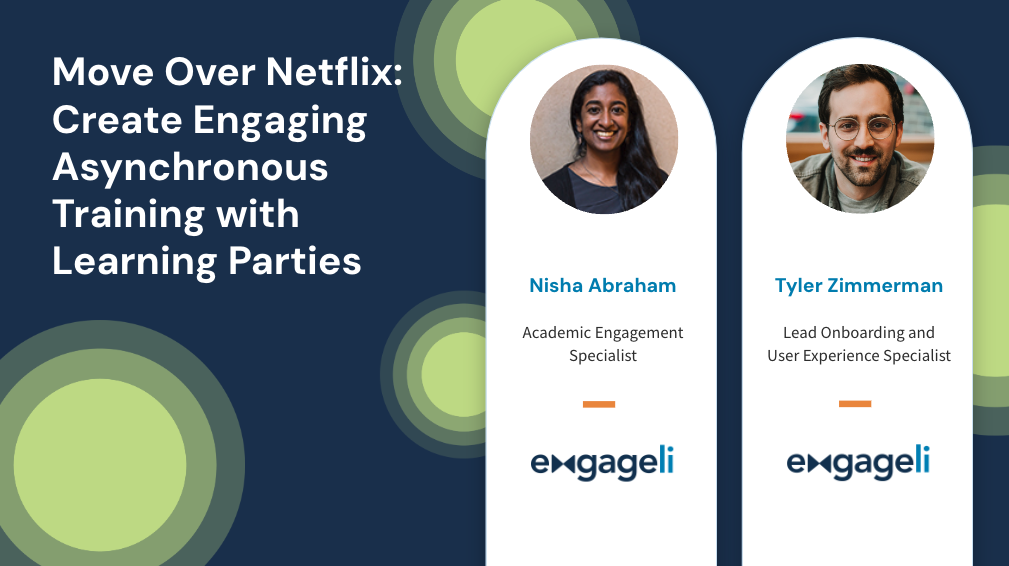What if online training sessions could be just as engaging as Netflix watch parties, while keeping all the flexibility of self-paced modules? In a world where Netflix has revolutionized the way we consume content, Engageli is on a mission to transform the way we learn and engage in asynchronous training.
Engageli has been on the road this month to join the online learning and L&D communities at DevLearn and OLC Accelerate. At these conferences, Engageli’s Nisha Abraham and Tyler Zimmerman led insightful sessions on a new way to make asynchronous sessions collaborative: learning parties.
Their guidance on this concept is set to help you make asynchronous training as engaging and captivating as watching your favorite shows on Netflix with friends. Join us below for a recap of their advice, and check out the full session in our Engageli Collaboration Space.
Current Trends in Learning and Development
To kick off the sessions, Nisha and Tyler explored several key trends within the learning and development space in 2022 and 2023.
Shift to Asynchronous Learning
With shrinking budgets and limited time, more companies are turning to asynchronous learning in L&D. While this offers increased flexibility, it also brings challenges in maintaining engagement and course completion levels.
Lack of Engaging Training
A majority of employees, at 55%, believe they need additional training to succeed in their roles. Yet, the average training course completion rate is only 20%. This disparity highlights the urgent need for training modules that not only educate but also engage.
Motivation and Social Learning
33% of employees find it challenging to stay motivated to complete training. Additionally, 32% prefer for training to be more social. This highlights a growing demand for collaborative learning experiences.
Online, Self-Paced Courses are Preferred
Despite the challenges, online, self-paced courses remain the preferred mode of learning by 70% of respondents. This presents an intriguing challenge: how can training be both social and self-paced?
Benefits of Social and Collaborative Learning in the Workplace
Next, the session focused in on one trend in particular: social and collaborative learning. This is a commonly used technique in higher education, but is less frequently used in workplace training.
Peer-to-peer learning in the workplace can take many forms, from managers empowering employees to learn from one another to tenured employees sharing knowledge with new hires. All of these forms of social learning have significant benefits for learners, including:
Increased Completion Rates: Social learning approaches have been shown to increase course completion rates. For instance, the introduction of social learning in HBX, a Harvard Business School online initiative, saw completion rates increase to 85%. Comparing this to the average training course completion rate of 20%, it's clear social learning has a significant impact!
Higher Return on Investment (ROI): Social learning approaches have a 75:1 ROI ratio compared to formal web-based training.
Boosted Productivity: Productivity gains enabled through using a social learning platform can be as high as 35%. In learning and development, a critical question is if employees can not only complete their training, but also apply what they’ve learned to their work and increase their productivity. Research is showing that social and collaborative training is able to cause these increases.
Individual Learning vs. Peer-to-Peer Learning
In the session's first learning activity, Nisha and Tyler asked attendees to complete an exercise that might commonly be found in a workplace training module - creating an action plan for change in the workplace. Attendees first worked alone on the exercise for several minutes, then were asked to pair up with a peer to work through the same scenario.
After working on the scenario both independently and in pairs, two questions were posed to attendees about the exercise. Below are some key takeaways:
How far did you see yourself getting in this exercise on your own?
• Depending on the amount of time given and the need, individuals could see themselves getting through the training module alone. However, they felt it would probably be difficult to stay motivated.
• When completing the training alone, you only get one perspective and can’t discuss with others their view points or ideas.
How deep were you able to get during the discussion with a peer or small group?
• Most of the groups reported being able to share perspectives, ideas, and have real discussions.
• Whether users were part of the same organization or from different organizations, units, or industries, they found value in discussing the similarities and differences of applying the concepts to this scenario.
• Some groups mentioned that they gained a lot of efficiency by dividing and conquering the work and got to the correct answers much more quickly in groups than if they had done the work alone.
How to Build Collaborative Asynchronous Learning Parties
As an answer to the challenge of creating training that is both social and self-paced, Nisha and Tyler introduced the concept of a learning party. Imagine a virtual space where peers can come together on flexible schedules from any location to engage, interact, and learn collaboratively.
In the session's second learning activity, participants were asked to pair up and discuss the following statement on what elements would be needed to bring this concept to life. Their responses are summarized below.
Discuss and generate core components needed for collaborative learning experiences through asynchronous delivery.
• The ideal platform for asynchronous learning should be user-friendly, intuitive, and secure.
• It should allow learners to engage in many ways, such as text, emojis, and videos.
• It should promote collaboration through integrated tools, allowing for discussion topics and group work.
• Lastly, it should provide data on training completion and clear parameters for success.
Participants responses aligned well with Nisha and Tyler's non-negotiable elements required to build effective and engaging learning parties:
Dynamic Content Delivery: Content delivery must allow for both flexibility and engagement. This includes leveraging multimedia, interactive documents, and dynamic web pages to foster as much interactivity as live sessions.
Universal Access: Learning experiences should be inclusive and easy to access, ensuring that everyone can participate effortlessly. This involves creating environments where learners can engage in small groups, fostering a sense of intimacy and connection.
Integrated, Comprehensive Toolkit: An integrated, comprehensive toolkit is critical to reduce complexity for learners in asynchronous sessions without live facilitators. This includes a suite of resources such as quizzes, polls, timers, and whiteboards, all accessible within the training platform itself.
Data-Driven Insights: Harnessing detailed accountability and engagement metrics is pivotal. Such data empowers instructors to tailor curriculum and learning paths, optimizing them based on real-time participation and engagement insights.
If you are interested in experiencing this session in a virtual collaboration platform that contains the above essential elements, and you are welcome to join our Engageli Collaboration Space. Leave a comment in the Q&A if you have additional ideas for core components needed to build collaborative, asynchronous learning experiences!
Meet the Presenters
Nisha Abraham, Academic Engagement Specialist.png?width=145&height=145&name=Live%20Webinar%20Instagram%20Post%20(1).png)
Nisha Abraham has over 15 years of combined industry, research, and higher education experience, and before joining Engageli worked as the assistant director of the Sanger Learning Center at The University of Texas at Austin. She specializes in instructional design, training and facilitation, and has served as an adjunct faculty member at South University. She received her BS in cell and molecular biology from The University of Texas at Austin in 2007, her MS in biology from Texas A&M University in 2012, and an MA in STEM education from The University of Texas at Austin in 2019.
Tyler Zimmerman, Lead Specialist of Onboarding and Initial User Experience
Tyler Zimmerman is leveraging his background as a higher education professional to enable more engaging and pedagogically-informed virtual learning experiences at Engageli. He has a passion for student success and uses a student-first approach to tackling contemporary issues in adult learning contexts. He is based in Portland, Oregon but is originally from Anchorage, Alaska.

